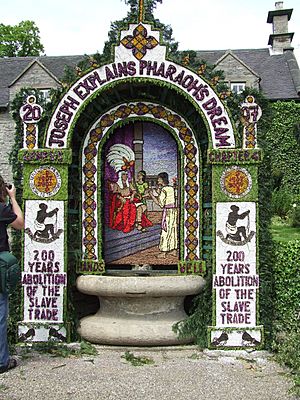Well dressing facts for kids

Well dressing, also known as well flowering, is a special tradition found in some parts of rural England. It involves decorating wells, springs, and other water sources. These decorations are beautiful designs made from flower petals and other natural materials. This custom is most famous in the Peak District area, which is in Derbyshire and Staffordshire. While other countries like Scotland and Ireland have a long history of respecting wells, this particular way of decorating them is not seen there. The custom of well dressing was first recorded in 1348 in Tissington. It grew from a simpler tradition of decorating wells with ribbons and basic flowers.
The Story of Well Dressing
The village most connected with well dressing is Tissington in Derbyshire. The exact start of this tradition is a bit of a mystery. Some people think it began as an old custom where people thanked their gods for a steady supply of water. Other ideas suggest villagers celebrated their clean water after surviving the terrible Black Death in 1348. Another thought is that they celebrated their water supply staying strong during a long dry period in 1615. However, using clay boards for well dressing in Tissington wasn't written down until 1818. The first record of wells being decorated with simple flower garlands was in 1758.

By the late 1800s, well dressing was celebrated in at least 12 villages in Derbyshire. It started in Buxton in 1840. This was to thank the Duke of Devonshire. He paid to bring excellent water to the Upper Town, which had been far from the main water source. Similarly, the tradition was brought back in Youlgreave. This celebrated water being supplied to the village from a distant hill through pipes. When piped water became common, the tradition changed. People started decorating public taps, but they still called these creations "well dressings."
The custom has become more or less popular over the years. But it has seen new life in Derbyshire, Staffordshire, South Yorkshire, Cheshire, Shropshire, Worcestershire, and Kent.
How Well Dressings Are Made
Making a well dressing is a careful process. First, wooden frames are built. These frames are then covered with wet clay mixed with water and salt. A design is drawn on paper, often with a religious theme. This design is then traced onto the clay.
The picture is then filled in using natural materials. These mostly include flower petals and moss. But they also use beans, seeds, and small cones. Each group that makes a well dressing has its own way of doing things. Some areas insist that only natural materials can be used. Others might use modern materials to make the process easier. Wirksworth and Barlow are two of the few places where only natural materials are strictly used.
Well Dressing in Books
Well dressing has even appeared in books! John Brunner's story "In the Season of the Dressing of the Wells" talks about the custom coming back to an English village after World War I. It also connects the tradition to a Goddess.
Jon McGregor's novel Reservoir 13 is set in a village where well dressing happens every year.

